2011 Peugeot 508 belt
[x] Cancel search: beltPage 155 of 340
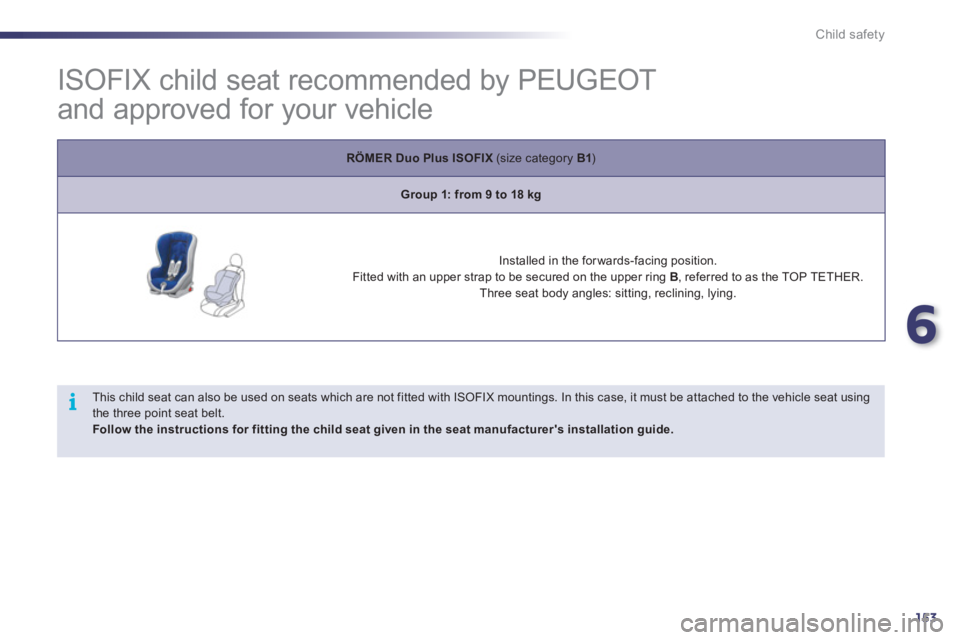
6
153
i
Child safety
ISOFIX child seat recommended by PEUGEOT
and approved for your vehicle
RÖMER Duo Plus ISOFIX
(size category B1
)
Group 1: from 9 to 18 kg
Installed in the for wards-facing position.
Fitted with an upper strap to be secured on the upper ring B
, referred to as the TOP TETHER.
Three seat body angles: sitting, reclining, lying.
This child seat can also be used on seats which are not fitted with ISOFIX mountings. In this case, it must be attached to the vehicle seat using
the three point seat belt.
Follow the instructions for fitting the child seat given in the seat manufacturer's installation guide.
Page 157 of 340
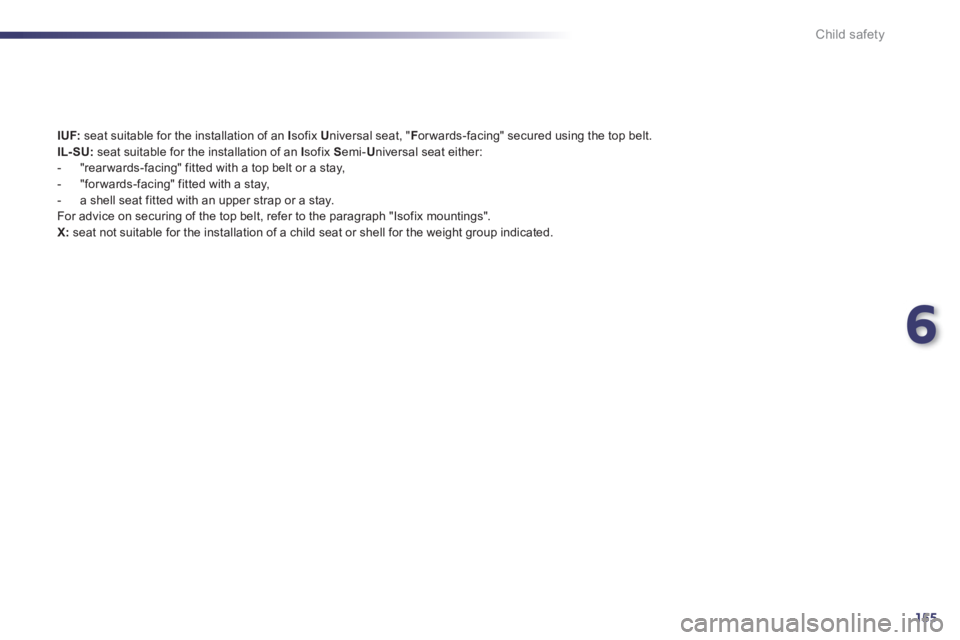
6
155
Child safety
IUF:
seat suitable for the installation of an I
sofix U
niversal seat, " F
or wards-facing" secured using the top belt.
IL-SU:
seat suitable for the installation of an I
sofix S
emi- U
niversal seat either:
- "rear wards-facing" fitted with a top belt or a stay,
- "for wards-facing" fitted with a stay,
- a shell seat fitted with an upper strap or a stay.
For advice on securing of the top belt, refer to the paragraph "Isofix mountings".
X:
seat not suitable for the installation of a child seat or shell for the weight group indicated.
Page 165 of 340
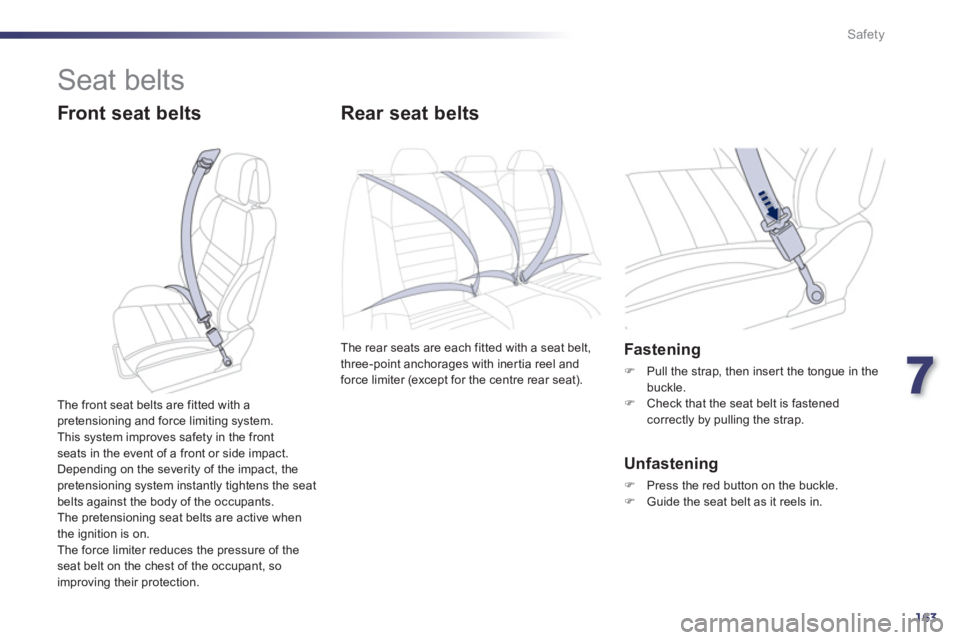
7
163
Safety
Seat belts
Front seat belts
Rear seat belts
The rear seats are each fitted with a seat belt,
three-point anchorages with iner tia reel and
force limiter (except for the centre rear seat).
Fastening
�)
Pull the strap, then inser t the tongue in the
buckle.
�)
Check that the seat belt is fastened
correctly by pulling the strap.
Unfastening
�)
Press the red button on the buckle.
�)
Guide the seat belt as it reels in.
The front seat belts are fitted with a
pretensioning and force limiting system.
This system improves safety in the front
seats in the event of a front or side impact.
Depending on the severity of the impact, the
pretensioning system instantly tightens the seat
belts against the body of the occupants.
The pretensioning seat belts are active when
the ignition is on.
The force limiter reduces the pressure of the
seat belt on the chest of the occupant, so
improving their protection.
Page 166 of 340
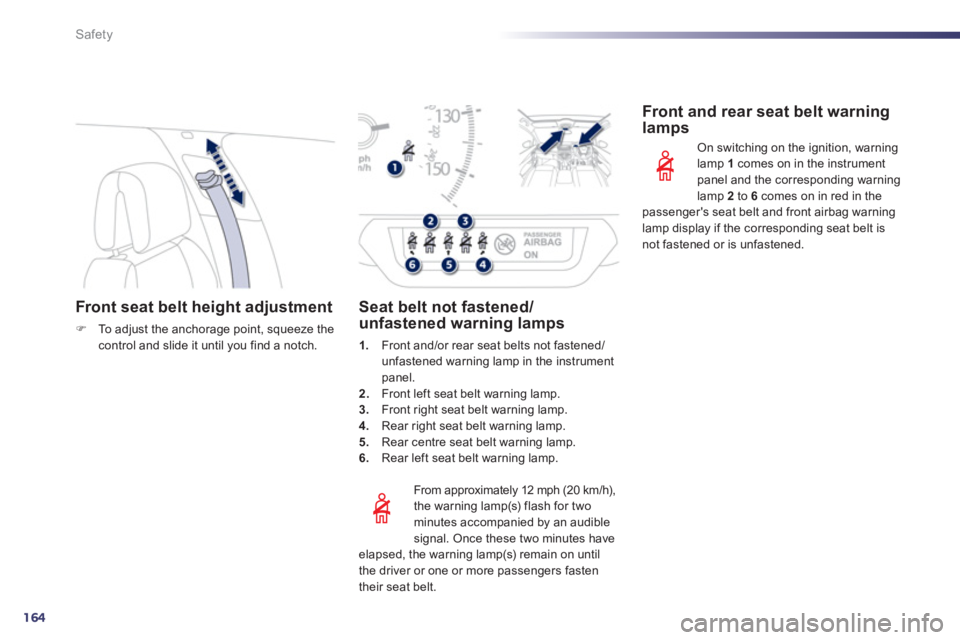
164
Safety
Front seat belt height adjustment
�)
To adjust the anchorage point, squeeze the
control and slide it until you find a notch.
From approximately 12 mph (20 km/h),
the warning lamp(s) flash for two
minutes accompanied by an audible
signal. Once these two minutes have
elapsed, the warning lamp(s) remain on until
the driver or one or more passengers fasten
their seat belt.
Seat belt not fastened/
unfastened warning lamps
1.
Front and/or rear seat belts not fastened/
unfastened warning lamp in the instrument
panel.
2.
Front left seat belt warning lamp.
3.
Front right seat belt warning lamp.
4.
Rear right seat belt warning lamp.
5.
Rear centre seat belt warning lamp.
6.
Rear left seat belt warning lamp.
Front and rear seat belt warning
lamps
On switching on the ignition, warning
lamp 1
comes on in the instrument
panel and the corresponding warning
lamp 2
to 6
comes on in red in the
passenger's seat belt and front airbag warning
lamp display if the corresponding seat belt is
not fastened or is unfastened.
Page 167 of 340
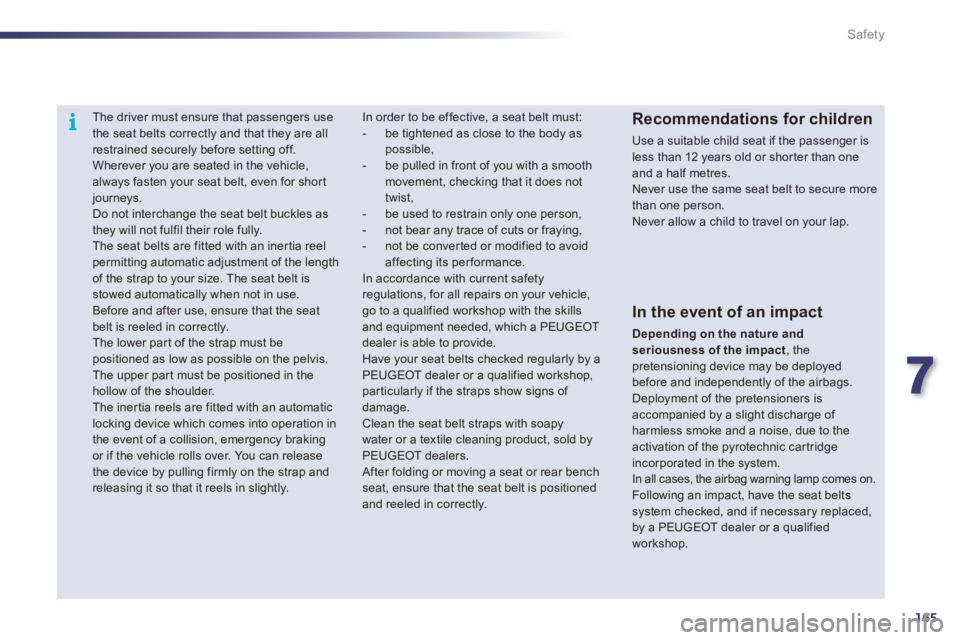
7
165
i
Safety
The driver must ensure that passengers use
the seat belts correctly and that they are all
restrained securely before setting off.
Wherever you are seated in the vehicle,
always fasten your seat belt, even for short
journeys.
Do not interchange the seat belt buckles as
they will not fulfil their role fully.
The seat belts are fitted with an iner tia reel
permitting automatic adjustment of the length
of the strap to your size. The seat belt is
stowed automatically when not in use.
Before and after use, ensure that the seat
belt is reeled in correctly.
The lower part of the strap must be
positioned as low as possible on the pelvis.
The upper par t must be positioned in the
hollow of the shoulder.
The iner tia reels are fitted with an automatic
locking device which comes into operation in
the event of a collision, emergency braking
or if the vehicle rolls over. You can release
the device by pulling firmly on the strap and
releasing it so that it reels in slightly.
Recommendations for children
Use a suitable child seat if the passenger is
less than 12 years old or shor ter than one
and a half metres.
Never use the same seat belt to secure more
than one person.
Never allow a child to travel on your lap. In order to be effective, a seat belt must:
- be tightened as close to the body as
possible,
- be pulled in front of you with a smooth
movement, checking that it does not
twist,
- be used to restrain only one person,
- not bear any trace of cuts or fraying,
- not be conver ted or modified to avoid
affecting its per formance.
In accordance with current safety
regulations, for all repairs on your vehicle,
go to a qualified workshop with the skills
and equipment needed, which a PEUGEOT
dealer is able to provide.
Have your seat belts checked regularly by a
PEUGEOT dealer or a qualified workshop,
par ticularly if the straps show signs of
damage.
Clean the seat belt straps with soapy
water or a textile cleaning product, sold by
PEUGEOT dealers.
After folding or moving a seat or rear bench
seat, ensure that the seat belt is positioned
and reeled in correctly.
In the event of an impact
Depending on the nature and
seriousness of the impact
, the
pretensioning device may be deployed
before and independently of the airbags.
Deployment of the pretensioners is
accompanied by a slight discharge of
harmless smoke and a noise, due to the
activation of the pyrotechnic car tridge
incorporated in the system.
In all cases, the airbag warning lamp comes on.
Following an impact, have the seat belts
system checked, and if necessary replaced,
by a PEUGEOT dealer or a qualified
workshop.
Page 168 of 340

166
i
!
Safety
Airbags
System designed to maximise the safety of the
occupants (with the exception of the rear centre
passenger) in the event of violent collisions.
It supplements the action of the force-limiting
seat belts (with the exception of the rear centre
passenger).
If a collision occurs, the electronic detectors
record and analyse the front and side impacts
sustained in the impact detection zones:
- in the case of a serious impact, the airbags
are deployed instantly and protect the
occupants of the vehicle (with the exception
of the rear centre passenger); immediately
after the impact, the airbags deflate rapidly
so that they do not hinder visibility or the
exit of the occupants,
- in the case of a minor or rear impact or in
cer tain roll-over conditions, the airbags
will not be deployed; the seat belt alone is
sufficient to provide optimum protection in
these situations.
The airbags do not operate when the
ignition is switched off.
This equipment will only deploy once.
If a second impact occurs (during
the same or a subsequent accident),
the airbag will not be deployed again. Deployment of the airbag(s) is
accompanied by a slight emission of
harmless smoke and a noise, due to the
activation of the pyrotechnic car tridge
incorporated in the system.
This smoke is not harmful, but sensitive
individuals may experience slight
irritation.
The noise of the detonation may result
in a slight loss of hearing for a short
time.
Impact detection zones
A.
Front impact zone.
B.
Side impact zone.
Front airbags
Deployment
The airbags are deployed simultaneously, unless
the passenger's front airbag is deactivated, in the
event of a serious front impact to all or par t of the
front impact zone A
, in the longitudinal centreline
of the vehicle on a horizontal plane and directed
from the front to the rear of the vehicle.
The front airbag inflates between the thorax
and head of the front occupant of the vehicle
and the steering wheel, driver's side, and the
dashboard, passenger's side to cushion their
for ward movement. System which protects the driver and front
passenger in the event of a serious front impact
in order to limit the risk of injury to the head and
thorax.
The driver's airbag is fitted in the centre of the
steering wheel; the front passenger's airbag is
fitted in the dashboard above the glove box.
Page 169 of 340
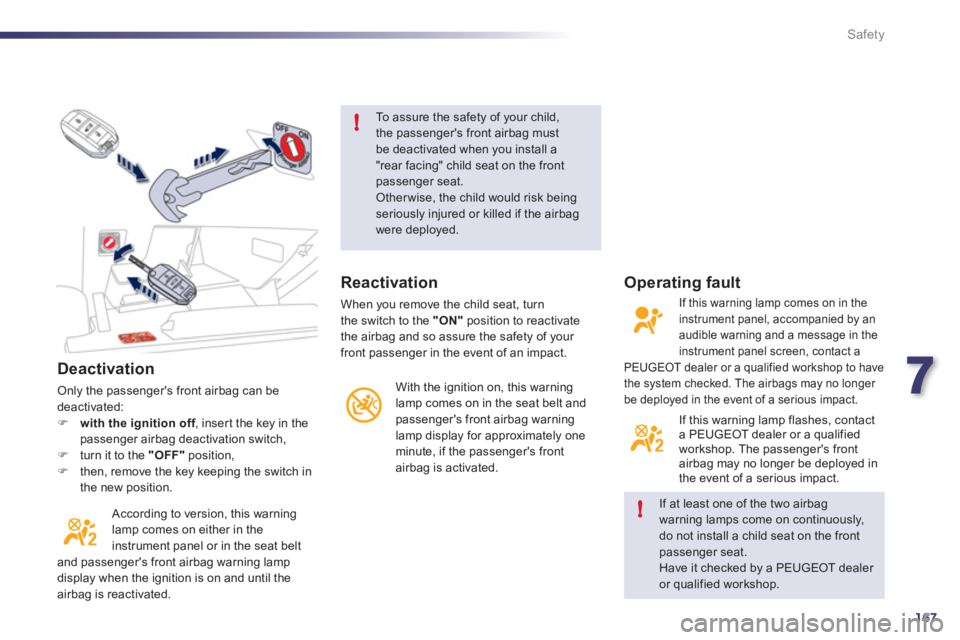
7
167
!
!
Safety
Deactivation
Only the passenger's front airbag can be
deactivated:
�)
with the ignition off
, inser t the key in the
passenger airbag deactivation switch,
�)
turn it to the "OFF"
position,
�)
then, remove the key keeping the switch in
the new position.
According to version, this warning
lamp comes on either in the
instrument panel or in the seat belt
and passenger's front airbag warning lamp
display when the ignition is on and until the
airbag is reactivated. To assure the safety of your child,
the passenger's front airbag must
be deactivated when you install a
"rear facing" child seat on the front
passenger seat.
Other wise, the child would risk being
seriously injured or killed if the airbag
were deployed.
If at least one of the two airbag
warning lamps come on continuously,
do not install a child seat on the front
passenger seat.
Have it checked by a PEUGEOT dealer
or qualified workshop.
Reactivation
When you remove the child seat, turn
the switch to the "ON"
position to reactivate
the airbag and so assure the safety of your
front passenger in the event of an impact.
With the ignition on, this warning
lamp comes on in the seat belt and
passenger's front airbag warning
lamp display for approximately one
minute, if the passenger's front
airbag is activated.
Operating fault
If this warning lamp comes on in the
instrument panel, accompanied by an
audible warning and a message in the
instrument panel screen, contact a
PEUGEOT dealer or a qualified workshop to have
the system checked. The airbags may no longer
be deployed in the event of a serious impact.
If this warning lamp flashes, contact
a PEUGEOT dealer or a qualified
workshop. The passenger's front
airbag may no longer be deployed in
the event of a serious impact.
Page 171 of 340
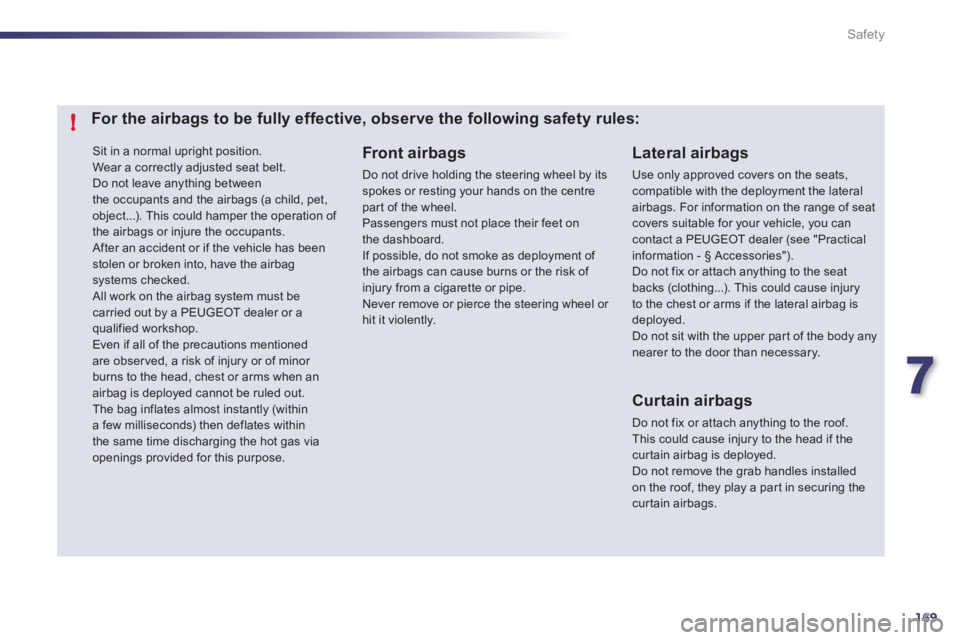
7
169
!
Safety
Sit in a normal upright position.
Wear a correctly adjusted seat belt.
Do not leave anything between
the occupants and the airbags (a child, pet,
object...). This could hamper the operation of
the airbags or injure the occupants.
After an accident or if the vehicle has been
stolen or broken into, have the airbag
systems checked.
All work on the airbag system must be
carried out by a PEUGEOT dealer or a
qualified workshop.
Even if all of the precautions mentioned
are obser ved, a risk of injury or of minor
burns to the head, chest or arms when an
airbag is deployed cannot be ruled out.
The bag inflates almost instantly (within
a few milliseconds) then deflates within
the same time discharging the hot gas via
openings provided for this purpose.
Lateral airbags
Use only approved covers on the seats,
compatible with the deployment the lateral
airbags. For information on the range of seat
covers suitable for your vehicle, you can
contact a PEUGEOT dealer (see "Practical
information - § Accessories").
Do not fix or attach anything to the seat
backs (clothing...). This could cause injury
to the chest or arms if the lateral airbag is
deployed.
Do not sit with the upper par t of the body any
nearer to the door than necessary.
Front airbags
Do not drive holding the steering wheel by its
spokes or resting your hands on the centre
part of the wheel.
Passengers must not place their feet on
the dashboard.
If possible, do not smoke as deployment of
the airbags can cause burns or the risk of
injury from a cigarette or pipe.
Never remove or pierce the steering wheel or
hit it violently.
Curtain airbags
Do not fix or attach anything to the roof.
This could cause injury to the head if the
cur tain airbag is deployed.
Do not remove the grab handles installed
on the roof, they play a par t in securing the
curtain airbags.
For the airbags to be fully effective, observe the following safety rules: